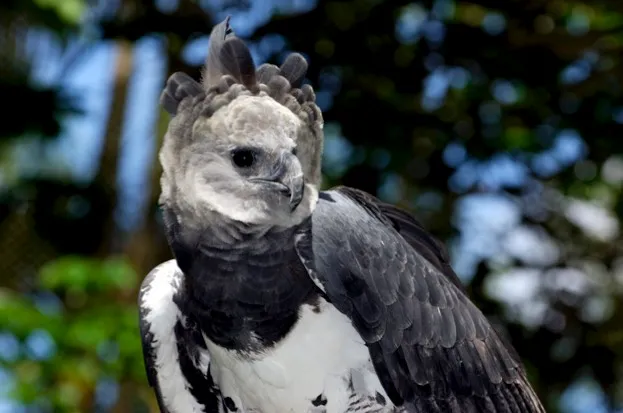We don’t often think of birds as dangerous, says Dominic Couzens. That’s a mistake, because to their prey species they are, of course, completely deadly.
Perhaps surprisingly, a few species can also be a peril to humans, and back in prehistoric times there were probably more. Here we will look both at the birds that can kill people, but also at a few species that seem to have a particularly heartless or clever way of destroying other living things.
- Silent assassins and tiny terrors: Meet the world's deadliest flies
- 10 deadliest countries for wildlife – including the one where Gustave the 'man-eating' crocodile lurks
- 10 deadliest animals to humans - discover the world's most lethal creatures
Deadliest birds in the world
Lammergeier (bearded vulture)

This vulture lives in the mountains of Europe, Asia and parts of Africa and it has a very peculiar diet – bones, in particular the marrow. It has a severely acid stomach in order to break bones down.
- Are there vultures in Europe?
- Feared and wildly misunderstood – the dark truth behind nature’s most vilified bird and its chilling reputation as a harbinger of death
However, this is not its most deadly feature, because to a Lammergeier, there isn’t much difference between a bone and the carapace of a tortoise. What these vultures do is to grab a tortoise in the talons, fly up to a height and then drop the tortoise on to the rocks below, before devouring the multiple pieces. How brutal is that?
Southern Cassowary

Cassowaries are the only modern birds that have been recorded killing humans in combat in the wild. Cassowaries are large, flightless birds of the forests of Northern Australia and New Guinea, like squashed, midriff-heavy ostriches, and they are armed with mighty legs and thick feet.
- “How worried should I be?” A quest through Australia's rainforest in search of the world's most dangerous bird
- There are probably more flightless birds than you think – Meet 11 curious - and often weird - land-based avian wonders
On the middle toe is a long (up to 12cm), very sharp, slightly curved claw. If a Cassowary is threatened, it can leap upwards and kick towards the danger, allowing the claw to slash the body of its combatant.
This slashing can cause fatal wounds in humans. This has been recorded once in Australia (in 1926), but probably occurs every so often in New Guinea, where Cassowaries are hunted. A Florida man was killed by his pet Cassowary in 2019.
We named the Southern Cassowary one of the weirdest birds in the world
Great Grey Shrike

When it comes to the gruesome consumption of prey, shrikes are so brutal that they have been given the nickname “Butcher birds.” These songbirds are highly predatory, eating large invertebrates and, often, small vertebrates such as other birds.
They have sharp bills and strong, formidably clawed feet. What makes them unusual is their habit of caching any food that they don’t eat immediately. The ideal place to store food is on thorns (and barbed wire is excellent, too). So, once they make a catch, they hook it up and leave for consumption later. No doubt, some prey isn’t yet dead before being strung up. Nasty.
Harpy Eagle

The huge harpy eagle is an apex predator of the rainforests of South and Central America. It is very rare and seldom seen but is famous for dividing its diet largely between two sets of medium-sized mammals, sloths and monkeys.
- It's as tall as a baseball bat, has legs as thick as wrists and is able to rip monkeys from branches with deadly talons: Meet the world's most powerful bird
- Meet the world's deadliest-ever eagles, including a 18kg raptor that terrified New Zealanders until its extinction in the 15th century
With a 2m wingspan and talons as broad as a grizzly bear’s claws, this is quite a package. In 2023, in French Guiana, an adult woman was attacked by a harpy eagle and was only rescued by her partner holding the bird down. There are a few other instances where others have been similarly attacked, none fatally. This is a bird that you should treat with respect.
Green Heron

The green heron spends much of its time being a conventional heron, waiting patiently by the water’s edge hoping that a fish will come in range so that it can strike and grab it. But let’s be honest, that is a bit of a boring way to catch your food.
So instead, the Green Heron has learned to find bait and drop it on the water surface, attracting fish straight to it. It sometimes uses lures such as leaves and twigs, but some have been seen using bread, and they may even use insects such as mayflies. It’s very clever, and deadly.
Crowned Eagle

It is vanishingly rare for anybody to be attacked by an eagle, but apart from the harpy eagle mentioned above, the Crowned Eagle, a widespread and common African eagle, is also a very occasional potential predator, at least of children. There is an authenticated story of a 7-year-old child being attacked and badly injured, and a child’s skull has also been found in a Crowned Eagle nest (it could have been scavenged).
Back in prehistory there might have been eagles around that could catch and eat people – the immense Haast’s eagle of New Zealand was twice as big as a harpy eagle and ate moas, New Zealand’s large extinct flightless birds.
Hooded Pitohui

Many animals around the world have evolved toxins to protect them from predators, but until the 1990s nobody had thought too much about birds being poisonous.
That’s when some researchers catching New Guinean birds in mist-nets discovered that, after handling the birds and, say, wiping their mouth, they found their lips burning and feeling numb.
After much analysis, they discovered that Pitohuis and some other birds did have toxins in their feathers, similar to those found in arrow-poison frogs. The amounts were very small, however, and pithouis don’t pose much risk, unless you put a lot in your Beef Wellington, perhaps…
Secretary-bird

The Secretary-bird is a curious looking bird, with peculiarly long legs that enable it to stride over the African savanna. With their wispy crests and partially feathered legs, they can look faintly amusing – but to their prey they are no laughing matter.
Small to medium sized animals, including large invertebrates, rodents, hedgehogs, mongooses and, especially snakes, are treated with great savagery. With its short claws, the Secretary-bird simply kicks most of its prey to death, and tramples on it. It may take snakes in its bill, fly up and drop them to the ground. It can be prolonged – and it is certainly deadly.
Peregrine Falcon

If there is a candidate for the world’s most dangerous birds – at least to other birds – it would have to be the peregrine falcon. Found worldwide, it has probably eaten more species of birds than anything else, mostly small to medium sized birds such as pigeons, but anything up to a goose.
- It's the fastest animal in the world and its deadly claws can catch prey mid-air: Meet one of the world's most incredible birds of prey
- How peregrines have adapted to urban living
It can do this, of course, in a very special way, often diving down in a manoeuvre known as a “stoop”, using gravity to accelerate it to extraordinary speeds, sometimes approach 300kmh. Not surprisingly, the talons hit the prey with great force, sometimes breaking the neck in an instant.
Vampire Ground-finch
It’s not the world’s deadliest bird, but it might just have the weirdest diet. The Vampire Ground-finch only lives on a couple of remote islands in the Galapagos and is a member of the famous “Darwin’s Finch” group that inspired Charles Darwin to think out evolutionary theory.
These birds are usually vegetarians, but in the dry season they take to a different diet – they drink the blood of the numerous seabirds, mainly boobies, that breed there. They use their sharp bills to make a wound, usually on the wings, and drink away. Several may swarm a single bird, which gets very irritated. It doesn’t kill them, as far as is known, but is certainly unpleasant.





